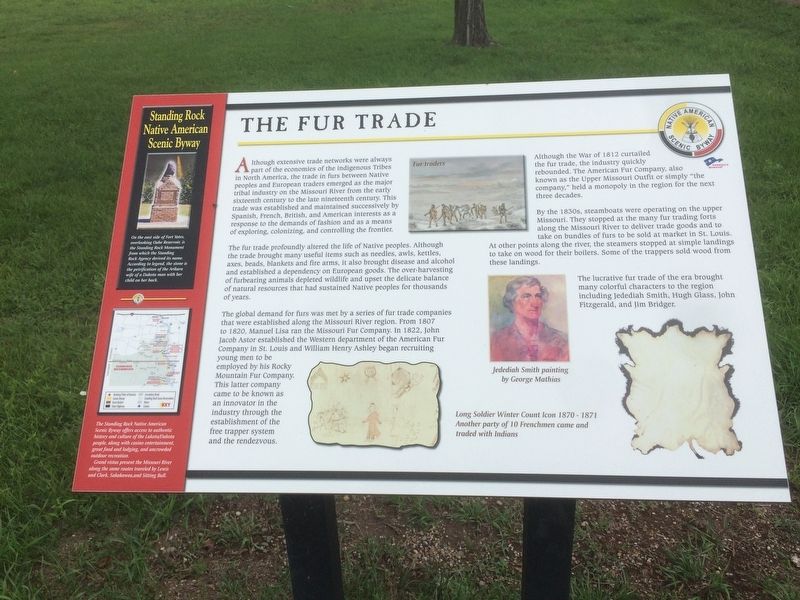Near Mobridge in Corson County, South Dakota — The American Midwest (Upper Plains)
The Fur Trade
Although extensive trade networks were always part of the economies of the indigenous Tribes in North America, the trade in furs between Native peoples and European traders emerged as the major tribal industry on the Missouri River from the early sixteenth century to the late nineteenth century. This trade was established and maintained successively by Spanish, French, British, and American interests as a response to the demands of fashion and as a means of exploring, colonizing, and controlling the frontier.
The fur trade profoundly altered the life of Native peoples. Although the trade brought many useful items such as needles, awls, kettles, axes, beads, blankets and fire arms, it also brought disease and alcohol and established a dependency on European goods. The over-harvesting of furbearing animals depleted wildlife and upset the delicate balance of natural resources that had sustained Native peoples for thousands of years.
The global demand for furs was met by a series of fur trade companies that were established along the Missouri River region. From 1807 to 1820, Manuel Lisa ran the Missouri Fur Company. In 1822, John Jacob Astor established the Western department of the American Fur Company in S. Louis and William Henry Ashley began recruiting young men to be employed by his Rocky Mountain Fur Company. This latter company came to be known as an innovator in the industry through the establishment of the free trapper system and the rendezvous.
Although the War of 1812 curtailed the fur trade, the industry quickly rebounded. The American Fur Company, also know as the Upper Missouri Outfit or simply "the company," held a monopoly in the region for the next three decades.
By the 1830s, steamboats were operating on the upper Missouri. They stopped at the many fur trading forts along the Missouri River to deliver trade goods and to take on bundles of furs to be sold at market in S. Louis. At other points along the river, the steamers stopped at simple landings to take on wood for their boilers. Some of the trappers sold wood from these landings.
The lucrative fur trade of the era brought many colorful characters to the region including Jedediah Smith, Hugh Glass, John Fitzgerald, and Jim Bridger.
Long Soldier Winter Count Icon 1870-1871
Another party of 10 Frenchmen came and traded with Indians
Standing Rock Native American Scenic Byway
On the east side of Fort Yates, overlooking Oahe Reservoir, is the Standing Rock Monument from which the Standing Rock Agency derived its name. According to legend, the stone is the petrification of the Arikara wife of a Dakota man with her child on her back.
The Standing Rock Native American Scenic Byway offers access to authentic history and culture of the Lakota/Dakota people, along with casino entertainment, great food and lodging, and uncrowded outdoor recreation.
Grand vistas present the Missouri River along the same routes traveled by Lewis and Clark, Sakakawea, and Sitting Bull.
Topics. This historical marker is listed in these topic lists: Industry & Commerce • Native Americans • Settlements & Settlers. A significant historical year for this entry is 1807.
Location. 45° 34.402′ N, 100° 29.21′ W. Marker is near Mobridge, South Dakota, in Corson County. Marker is at the intersection of U.S. 12 and State Highway 1806 on U.S. 12. This marker is located in a roadside park on an island in the Missouri River at the Hwy 12 western approach to the Mobridge Bridge. Touch for map. Marker is in this post office area: Mobridge SD 57601, United States of America. Touch for directions.
Other nearby markers. At least 8 other markers are within 3 miles of this marker, measured as the crow flies. Leavenworth Battle (a few steps from this marker); Jedediah Smith (within shouting distance of this marker); The Arikara People (within shouting distance of this marker); Native American Scenic Byway (within shouting distance of this marker); "MO.Bridge" (approx. 2.1 miles away); History Beneath the Waters (approx. 2.1 miles away); Ensign Nathaniel Pryor (approx. 2.4 miles away); Lewis & Clark (approx. 2.4 miles away). Touch for a list and map of all markers in Mobridge.
Credits. This page was last revised on January 27, 2018. It was originally submitted on January 25, 2018, by Ruth VanSteenwyk of Aberdeen, South Dakota. This page has been viewed 225 times since then and 26 times this year. Photo 1. submitted on January 25, 2018, by Ruth VanSteenwyk of Aberdeen, South Dakota. • Andrew Ruppenstein was the editor who published this page.
